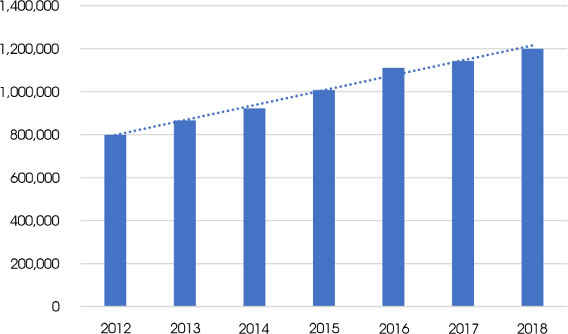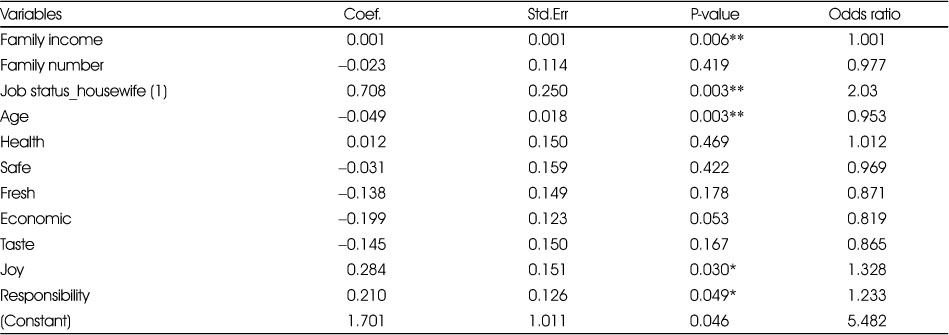Articles
- Page Path
- HOME > Korean J Community Nutr > Volume 24(4); 2019 > Article
-
Research Article
- The Effect of Consumers' Factors of Food Choices on Replacing Soft Drinks with Carbonated Water
-
Seoyoung Park
 , Dongmin Lee
, Dongmin Lee , Jaeseok Jeong
, Jaeseok Jeong , Junghoon Moon
, Junghoon Moon
-
Korean Journal of Community Nutrition 2019;24(4):300-308.
DOI: https://doi.org/10.5720/kjcn.2019.24.4.300
Published online: August 31, 2019
1Department of Agricultural Economics and Rural Development, Seoul National University, Korea, Graduate Student.
2Research Institute of Agriculture and Life Sciences, Korea, Research Engineer.
3Graduate School of Pan-Pacific International Studies, Kyung Hee University, Korea, Professor.
4Department of Agricultural Economics and Rural Development, Seoul National University, Korea, Professor.
- Corresponding author: Junghoon Moon. Department of Agricultural Economics and Rural Development, Seoul National University, 1 Gwanakro, Gwanakgu, Seoul, Korea. Tel: (02) 880-4722, Fax: (02) 873-5080, moonj@snu.ac.kr
Copyright © 2019 The Korean Society of Community Nutrition
This is an Open-Access article distributed under the terms of the Creative Commons Attribution Non-Commercial License (http://creativecommons.org/licenses/by-nc/3.0/) which permits unrestricted non-commercial use, distribution, and reproduction in any medium, provided the original work is properly cited.
- 912 Views
- 8 Download
- 1 Crossref
Abstract
-
Objectives
- This research was conducted to identify the consumers' food choice factors that affect the consumers' replacement of soft drinks with carbonated water.
-
Methods
- The present study used secondary data from a consumer panel survey conducted by the Rural Development Administration of Korea, and the data included the panel members' purchase records based on their monthly spending receipts. The survey asked the participants about their food choice factors and their personal responsibility for their health. This survey included independent variables for the consumers' food purchase factors. As a dependent variable, two types of groups were defined. The replacement group included those people who increased their purchase of carbonated water and decreased their purchase of soft drinks. The non-replacement group included those people who did not change their purchase patterns or they increased their purchase of soft drinks and they decreased their purchase of carbonated water. Logistic regression analysis was conducted to determine the consumers' food choice factors that were associated with replacing soft drinks with carbonated water.
-
Results
- The replacement group was significantly associated with (1) a younger age (OR=0.953), (2) being a housewife (OR=2.03), (3) higher income (OR=1.001) and (4) less concern about price (OR=0.819) when purchasing food. This group also showed (5) higher enjoyment (OR=1.328) when choosing food and (6) they took greater responsibly for their personal health (OR=1.233).
-
Conclusions
- This research is the first study to mainly focus on soft drinks and carbonated water. The result of this research showed that young, health-conscious consumers with a higher income and who are more interested in food have more possibilities to replace soft drinks with carbonated water. These research findings may be applied to consumers who have characteristics that are similar to the young health-conscious consumers and the results can help to suggest ways to reduce sugar intake and improve public health. However, this research has a limitation due to the application of secondary data. Therefore, a future study is needed to develop detailed survey questions about food choice factors and to extend these factors to all beverages, including soft drinks made with sugar substitutes, so as to reflect the growth of alternative industries that use artificial sweeteners or different types of sugar to make commercially available drinks.
Acknowledgments
Acknowledgments
- 1. World Health Organization. WHO guide to identifying the economic consequences of disease and injury. Geneva: World Health Organization; 2009. p. 1-100.
- 2. Meier T, Senftleben K, Deumelandt P, Christen O, Riedel K, Langer M. Healthcare costs associated with an adequate intake of sugars, salt and saturated fat in Germany: A health econometrical analysis. PLoS One 2015; 10(9): e0135990.ArticlePubMedPMC
- 3. Lee YC. An analysis of the current status of medical utilization for chronic diseases in Korea: Focused on medical expenses. Korea Health Industry Development Institute; 2015 11. Report No. 203.
- 4. Oh K, Lee H, Hu S, Shin Y, Oh J, Hwang K. A study on the dietary pattern and intake of potentially hazardous nutrients among Korean adults. National Institute of Food and Drug Safety Evaluation; 2017 12. Report No. TRKO201800035695.
- 5. Ministry of Food and Drug Safety. 1st Action plan for sugars reduction [internet]. Ministry of Food and Drug Safety; 2016; cited 2019 May 16]. Available from: https://www.mfds.go.kr/.
- 6. World Health Organization. Healthy diet [internet]. World Health Organization; 2018; updated 2018 Oct 23]. cited 2019 Jul 31]. Available from: https://www.who.int/news-room/fact-sheets/detail/healthy-diet.
- 7. World Health Organization. Taxes on sugary drinks: Why do it?[internet]. World Health Organization; 2017; cited 2019 May 31]. Available from: https://apps.who.int/iris/handle/10665/260253.
- 8. Food and Drug Administration. Guidance for industry: Food labeling guide [internet]. Food and Drug Administration; 2013; updated 2013 Jan]. cited 2019 May 31]. Available from: https://www.fda.gov/regulatory-information/search-fda-guidancedocuments/guidance-industry-food-labeling-guide.
- 9. Fletcher JM, Frisvold DE, Tefft N. The effects of soft drink taxes on child and adolescent consumption and weight outcomes. J Public Econ 2010; 94(11): 967-974.Article
- 10. Block JP, Chandra A, McManus KD, Willett WC. Point-ofpurchase price and education intervention to reduce consumption of sugary soft drinks. Am J Public Health 2010; 100(8): 1427-1433.ArticlePubMedPMC
- 11. Fletcher JM, Frisvold D, Tefft N. Can soft drink taxes reduce population weight? Contemp Econ Policy 2010; 28(1): 23-35.ArticlePubMedPMC
- 12. Genschow O, Reutner L, Wänke M. The color red reduces snack food and soft drink intake. Appetite 2012; 58(2): 699-702.ArticlePubMed
- 13. Billich N, Blake MR, Backholer K, Cobcroft M, Li V, Peeters A. The effect of sugar-sweetened beverage front-of-pack labels on drink selection, health knowledge and awareness: An online randomised controlled trial. Appetite 2018; 128: 233-241.ArticlePubMed
- 14. Swithers SE. Not-so-healthy sugar substitutes? Curr Opin Behav Sci 2016; 9: 106-110.ArticlePubMedPMC
- 15. Husøy T, Mangschou B, Fotland TØ, Kolset SO, Jakobsen HN, Tømmerberg I. Reducing added sugar intake in Norway by replacing sugar sweetened beverages with beverages containing intense sweeteners - a risk benefit assessment. Food Chem Toxicol 2008; 46(9): 3099-3105.ArticlePubMed
- 16. Griffioen-Roose S, Smeets PA, Weijzen PL, van Rijn I, van den Bosch I, de Graaf C. Effect of replacing sugar with non-caloric sweeteners in beverages on the reward value after repeated exposure. PLoS One 2013; 8(11): e81924.ArticlePubMedPMC
- 17. Elfhag K, Tynelius P, Rasmussen F. Sugar-sweetened and artificially sweetened soft drinks in association to restrained, external and emotional eating. Physiol Behav 2007; 91(2-3): 191-195.ArticlePubMed
- 18. Zheng M, Rangan A, Olsen NJ, Andersen LB, Wedderkopp N, Kristensen P. Substituting sugar-sweetened beverages with water or milk is inversely associated with body fatness development from childhood to adolescence. Nutrition 2015; 31(1): 38-44.ArticlePubMed
- 19. Korea Agro-Fisheries&Food Trade Corporation. 2016 Processed food segment market report: Carbonated water. Korea Agro-Fisheries&Food Trade Corporation; 2016 12. Report No. 11-1543000-001380-01.
- 20. Jeong JM. US drink market, killing two birds with one stone: taste and health [internet]. Kotra; 2016; updated 2016 May 09]. cited 2019 May 31]. Available from: https://news.kotra.or.kr/user/globalBbs/kotranews/782/globalBbsDataView.do?setIdx=243&dataIdx=149898.
- 21. International Bottled Water Association. 2018 IBWA progress report [internet]. International Bottled Water Association; 2019; updated 2019 Jan 04]. cited 2019 May 31]. Available from: https://www.bottledwater.org/newsroom/ibwa-annual-report.
- 22. Kotra. US bottled water trend [internet]. Kotra; 2019; updated 2019 May 29]. cited 2019 Jun 03]. Available from: http://news.kotra.or.kr/user/globalBbs/kotranews/782/globalBbsDataView.do?setIdx=243&dataIdx=175083.
- 23. Randall E, Sanjur D. Food preferences-their conceptualization and relationship to consumption. Ecol Food Nutr 1981; 11(3): 151-161.Article
- 24. Shepherd D. Dietary salt intake. Nutr Food Sci 1985; 85(5): 10-11.Article
- 25. Ministry of Food and Drug Safety. Korean food standards codex[internet]. Ministry of Food and Drug Safety; 2019; updated 2019 Mar 08]. cited 2019 May 31]. Available from: https://www.foodsafetykorea.go.kr/portal/safefoodlife/food/foodRvlv/foodRvlv.do.
- 26. Kim I, Byun J. A study on the influence of 20’s consumer’s lifestyle on purchase intention of carbonated water. Korean J Hosp Tour 2018; 27(6): 205-223.Article
- 27. Steptoe A, Pollard TM, Wardle J. Development of a measure of the motives underlying the selection of food: the food choice questionnaire. Appetite 1995; 25(3): 267-284.ArticlePubMed
- 28. Solheim R, Lawless HT. Consumer purchase probability affected by attitude towards low-fat foods, liking, private body consciousness and information on fat and price. Food Qual Prefer 1996; 7(2): 137-143.Article
- 29. Clark JE. Taste and flavour: their importance in food choice and acceptance. Proc Nutr Soc 1998; 57(4): 639-643.ArticlePubMed
- 30. Ong LM, De Haes JC, Hoos AM, Lammes FB. Doctor-patient communication: A review of the literature. Soc Sci Med 1995; 40(7): 903-918.ArticlePubMed
- 31. Brashers E, Haas M, Klingle S, Neidig L. Collective AIDS activism and individuals' perceived self-advocacy in physician-patient communication. Hum Commun Res 2000; 26(3): 372-402.Article
- 32. Dutta-Bergman MJ. Primary sources of health information: comparisons in the domain of health attitudes, health cognitions, and health behaviors. Health Commun 2004; 16(3): 273-288.ArticlePubMed
- 33. Kwon O. Linking health risk information seeking and health behavioral intentions. Korean J Consum Advert Psychol 2017; 18(2): 293-313.Article
- 34. Lee S, Son H, Lee D, Kang H. The influence of e-health literacy, subjective health status, and health information seeking behavior on the internet on health promoting behavior. Korean Soc Wellness 2017; 12(4): 55-67.Article
- 35. Basu A, Dutta MJ. The relationship between health information seeking and community participation: the roles of health information orientation and efficacy. Health Commun 2008; 23(1): 70-79.ArticlePubMed
- 36. Korea Agro-Fisheries&Food Trade Corporation. 2017 Processed food segment market report: Sugar. Korea Agro-Fisheries&Food Trade Corporation; 2017 12. Report No. 11-1543000-002048-01.
- 37. NielsenKorea. Soft drinks retail sales [internet]. aT Food Information Statistics System; 2018; cited 2019 May 31]. Available from: http://www.atfis.or.kr/sales/M002020000/search.do?searchItem=CD00000575&searchDivision=CD00000601&searchCompany=2&searchYear=2018&searchQuarter=T&x=79&y=13.
REFERENCES
General characteristics of subjects stratified according to replacement status

n, number; SD, standard deviation
Values are presented in mean ± SD or n (%)
1) Who increased purchase of carbonated water and decreased purchase of soft drink.
2) Who did not change a purchase pattern or who increased purchase of soft drink and decreased carbonated water.
3) Number of family member
4) Average monthly household income (Unit: KRW 10 thousand)
Figure & Data
REFERENCES
Citations

- Effects of the Dietary Behavior-Related Consumer Competency on the Purchase Satisfaction of Fresh Food via Early-Morning Delivery Service
Soon-Ok Lee, Ji-Young Kim, Seung-Min Lee
Journal of the Korean Society of Food Science and Nutrition.2021; 50(6): 612. CrossRef


Fig. 1
Fig. 2
General characteristics of subjects stratified according to replacement status
n, number; SD, standard deviation
Values are presented in mean ± SD or n (%)
1) Who increased purchase of carbonated water and decreased purchase of soft drink.
2) Who did not change a purchase pattern or who increased purchase of soft drink and decreased carbonated water.
3) Number of family member
4) Average monthly household income (Unit: KRW 10 thousand)
Descriptive statistics of survey variables
Loading of survey items
Correlation among constructs
1) The diagonal elements are squared roots of AVEs
Logit estimates for substitute of carbonated water
1) *: p<0.05, **: p<0.01
2) Nagelkerke R2=0.115, Hosmer-Lemeshow test p-value: 0.628
n, number; SD, standard deviation Values are presented in mean ± SD or n (%) 1) Who increased purchase of carbonated water and decreased purchase of soft drink. 2) Who did not change a purchase pattern or who increased purchase of soft drink and decreased carbonated water. 3) Number of family member 4) Average monthly household income (Unit: KRW 10 thousand)
1) The diagonal elements are squared roots of AVEs
1) *: p<0.05, **: p<0.01 2) Nagelkerke

 KSCN
KSCN






 PubReader
PubReader Cite
Cite


